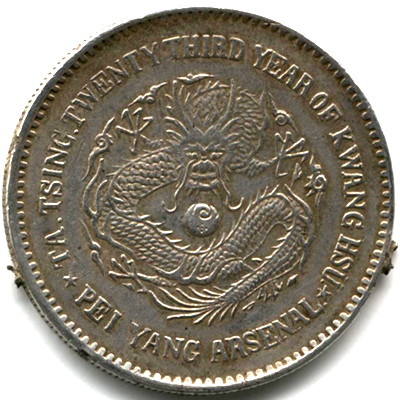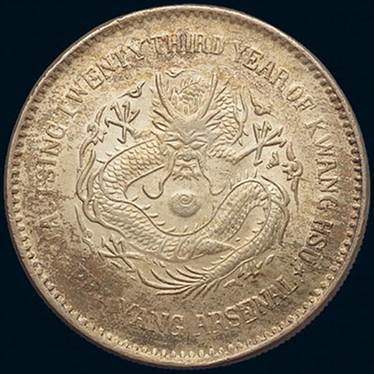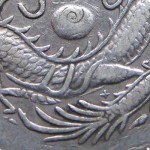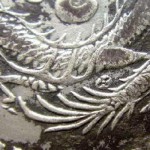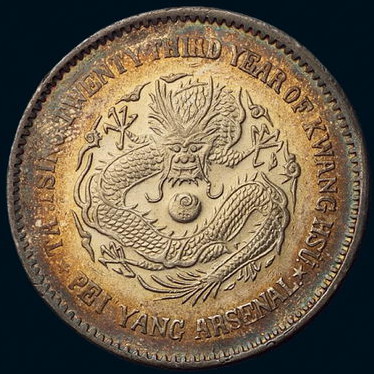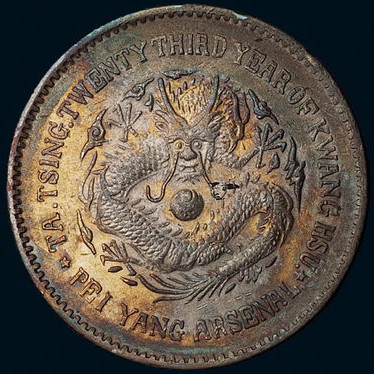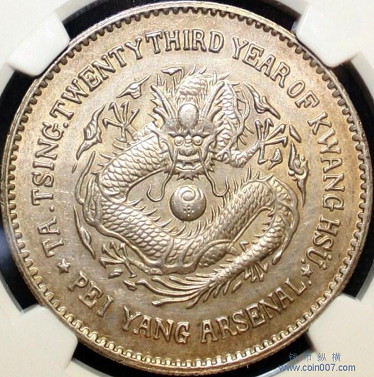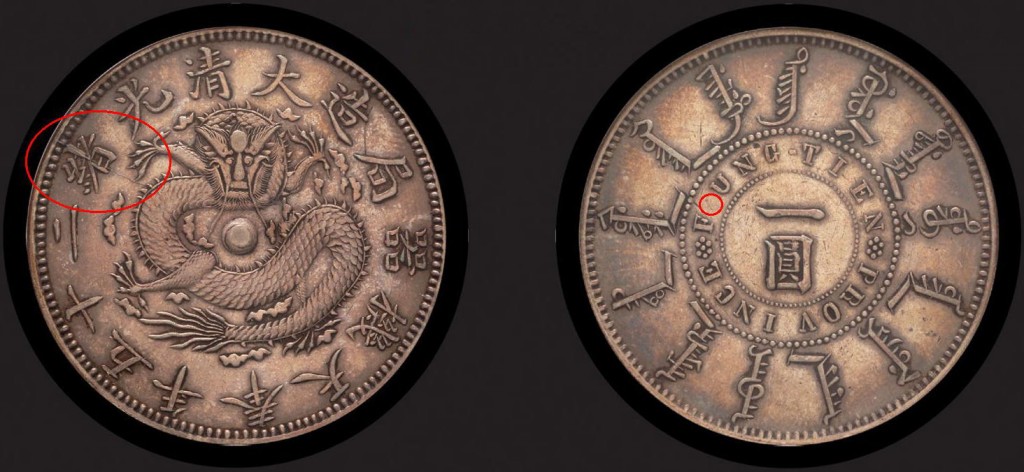A reader from Germany contacted me recently about an enigmatic coin he bought on the flea market for 5 Euros. While not a coin collector, he loves curiosities and was profundly intrigued by this unusual Dragon Dollar…
… a beautiful Almond Eyed Dragon from the Peiyang Arsenal mint, one of the rarest variety of an already scarce type. It was obviously handled with great care; the dragon had kept all its scales, his fierce eyes still as piercing as a hundred years ago, when it first went out of the Peiyang Arsenal.
Without the mounting marks at 4 and 8 o’clock, this coin would be worth at least 4,000 Euros!
The design of the early Peiyang dragons is interesting as it is very strictly conforming to the traditional nine anatomical attributes of the Chinese Dragon:
- Deer horns
- Camel head
- Demon eyes
- Bull ears
- Snake neck
- Sea-serpent (蜃) belly
- Carp scales
- Eagle claws
- Tiger soles
Additionally, the Chinese dragon has a growth on his forehead, the Chĭ Mù (尺木), without which it is unable to ascend to the sky (龙无尺木,无以升天).
The depiction of the dragon on the coins issued in the 23rd year of Guāng Xù has been altered multiple times, with most changes related to the dragon’s eyes – probably due to the difficulty in finding a Demon to pose and capture its gaze…
The Evil-eyed Dragon (三角眼)
The dragon engraved on this first variety has evil, sightless “Triangle Eyes“, not unlike the 1896 test piece. It had most likely a high mintage, since it is only slightly scarcer than the most common variety for this year, the Beady Eyed Dragon, but it is hard to find in good condition nonetheless. Most of the surviving coins are worn out and damaged. There exists two additional variations of the “Evil Eyed Dragon”, both extremely rare:
The Almond-eyed Dragon (过渡眼三角眼)
This beautiful die variation can seem superficially very similar to the Evil Eyed Dragon, with only the addition of irides to the previously blind triangle eyes. However, by looking carefully, one can see clearly that this variety is not a mere modification of the original “Evil Eyed Dragon” but a whole revision of the initial pattern. The shape of the clouds surrounding the dragon is different, more intricate. The thigh of the dragon is now shorter. Five dots disposed in a cross pattern were also added to the pearl of wisdom. This type is only second in rarity to the mysterious Hidden Cross and Hidden Rose varieties.
The Beady-eyed Dragon (圆眼龙)
The Beady Eyed Dragon (which is the most common variant of the 1897 Peiyang dollar) has rounded eyes, contrary to the all the previous dies made that year. Like the Almond Eyed Dragon, it is a complete redesign, with the surrounding clouds and the shape of the eyes being modified. The change from a triangular to a rounded shape will persist in all the subsequent issues of the Peiyang mint.
The Dog-headed Dragon (狗头龙)
This very rare type is the last one minted in the 23rd year of Kwang Hsü. The dragon’s head has been completely redesigned, with short horns and a much bigger Chĭ Mù (尺木) on his forehead. The shape and style of the clouds has also been refined. This coin likely served as the prototype for the 24th year of Guāng Xù dollar, which keeps most of the new cloud details and the same Dragon face, although engraved in a crude fashion. The very striking difference in style makes me wonder if the Dog Headed Dragon dies could have been commissioned from another mint, but there is no conclusive evidence to support this theory.
All these dragon dollars are hard to find nowadays, due to the initial unpopularity of these coins: they were the first Chinese coinage denominated in Yuan (圆) and Jiao (角), while the whole country was still using the traditional monetary system based on weight. Their rejection caused most of them to be melted in order to mint new coins denominated in Mace and Candareens.
Congratulations to our German reader for making such a wonderful Snäppchen!
I had previously written about the 25th year of Kwang Hsu Fengtien dollars, which is one of my favourite Chinese silver dollars. I would like to complete my previous article by introducing another interesting die variation, which brings the total to 4 main variations for this one year type coin.
1st variation: Smiling Dragon, Pearl Circle (细龙珠圈)
This is most likely the first variation produced. The style is very similar to the one of the previous year, and it is very well executed. However, die engraving is quite a technical art, and a small mistake can lead to damaged dies and coins defects. This particular variation was unfortunately afflicted with a die crack running through the 绪 character. The severity of the die crack varies depending on the time the coin was struck, but it is always present on genuine coins. You will also notice that the swirl on the fireball is weakly struck. On the reverse, there is a problem with typography (bad spacing between F and U) and weak strike (on G -).
2nd variation: Crude Dragon, Pearl Circle (粗龙珠圈)
This variation is a complete redesign of the previous one. It is likely that this pair of dies was made as soon as the defects of the previous one were known. Compared to its predecessor, it seems like a rushed job. The face of the dragon looks flat and crude compared to the first version. The spacing of the Chinese characters is unbalanced (局 and 造 are too close, 年 and 奉 as well), while the legend of the first version was evenly spaced. The reverse was improved though, the bad spacing in the English text was fixed and it is now clearly struck, however it was the turn of the pearl circle to suffer from weak strike.
3rd variation; Crude Dragon, Double Circle (粗龙双圈)
While overall the 25th year of Guang Xu Fengtien coins are rare, some variations are scarcer than others. The coins with a single circle of pearls are more common than the double circle variations. The first variation to present this double circle is actually an incremental revision of the 2nd variation. The obverse was reworked to correct the chinese characters spacing and slightly improve the dragon pattern, which remains cruder than the 1st design.
On the reverse, I suspect the solid circle was added while correcting the weak strike on the pearl circle. By superposing a pictures of the 2nd and 3rd variation, it is easy to see that the dragon pattern was heavily modified, but that the die for the reverse is virtually identical – only the circle was added. However, as seen above, it was now TIEN which was weakly struck…
4th variation: Smiling Dragon, Double Circle (细龙双圈)
This is the additional version that I want to introduce. It is in my opinion the most interesting variation for this coin. The reverse has been completely reworked, keeping the solid circle. The manchu script has been fixed, and the whole face is well struck.
However, a die crack appeared at 5 o’clock.
The dragon design has been updated as well, in the fine style of the 1st variation. Its face is artfully designed, in the fashion of previous Fengtien coins, with the smiling dragon seemingly flying toward the high relief fireball.
The dragon is much smaller than the one featured on the cruder variations, and the spacing of the Chinese legend has been improved as well, which makes this obverse much more balanced and good looking.
I believe this variation was the last silver dollar minted at the Fengtien machine bureau before the short lived 1903 dollar, four years later. Indeed, this particular design is often seen with a huge die crack on the reverse, and late samples seem to have been struck with very worn out and damaged dies. This leads me to believe no more dies were made afterward and the last ones were used until they broke down, their degradation mirroring the one of the political situation in the Fungtien province.
